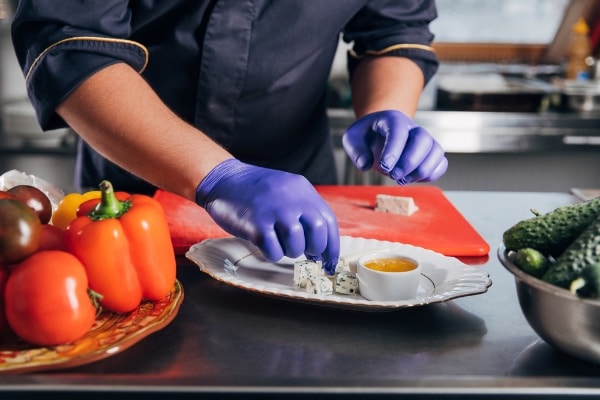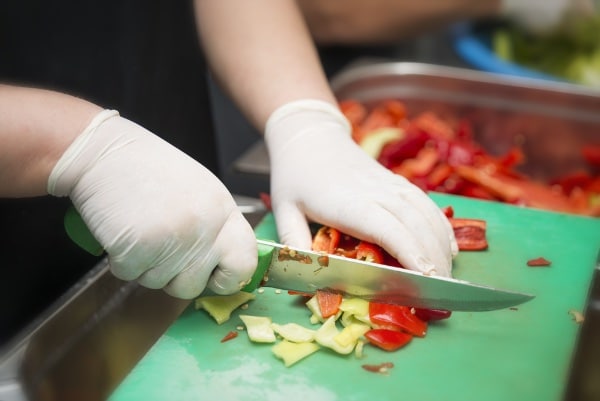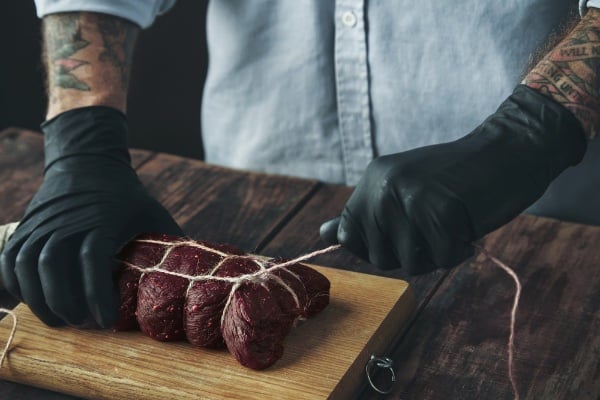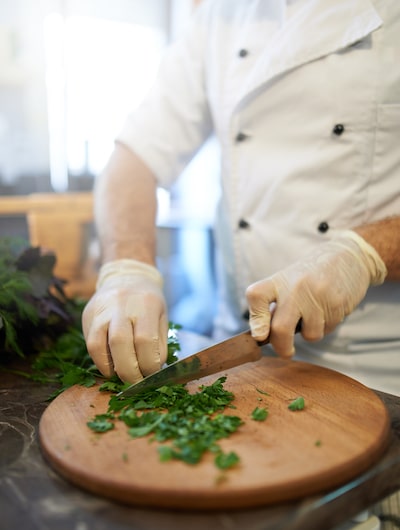When Are Food Workers Required To Wear Gloves?

The name of the game in the food industry is to serve amazing meals. But part of that is ensuring everything is safe and free of pathogens that might cause a food handling illness.
Heat treatment helps to reduce contaminated ingredients. But employees are on the front line of food safety when they prepare and serve food.
Producing safe food means limiting skin contact. The industry has plenty of tools to avoid foodborne illness, like tongs, spoons, and other utensils. Dishes and deli paper are other valuable barriers.
Out of all the protective measures, gloves are an essential tool to limit skin contact with food. It can be confusing to understand the varying safety rules, though.
Read on for advice on both the law and best practices. We also have a full Food Handling Training video if you’d like to take a look at that as well.
Do You Need To Wear Gloves In Food Service?
There are no hard-and-fast federal laws and few state laws around who is required to wear gloves. However, the FDA does recommend avoiding any bare hand contact in food service.
Wearing gloves is best practice for many jobs in food service, especially for hands-on tasks like making sandwiches or preparing salads.
It’s perhaps more important that people responsible for preparing food be aware that food is easily contaminated. You reduce contamination risk and increase food safety by correctly and properly serving food. The subject of cross-contamination is so vital that we did a completely separate write up on that.

What Are The Laws Around Gloves In Food Service?
Depending on your municipality, employees at restaurants may be required to wear gloves or use another barrier when handling ready-to-eat food. New York City has some of the most significant such regulations.
Contact your county health inspection if you need advice on the correct food safety procedures for your employees.
When Should Food Workers Wear Gloves?
There’s one hard and fast rule around wearing gloves: if food handlers have cuts, burns, or other open wounds on their hands, they need to wear gloves.
Although food handlers should never wear nail polish, if they have it on, they must also wear hand protection.
In all other instances, gloves are an effective tool in the fight against dangerous pathogens, but they are not the be-all, end-all. Bare hands can be used for most tasks, provided they are clean.

Are Gloves Recommended For Ready-To-Eat Foods?
Ready-to-eat food is when wearing gloves is most important. While gloves are strongly recommended when preparing food in the kitchen, gloves should always be worn when handling food ready for the customer.
What Is Ready-To-Eat Food?
Ready-to-eat food is any food ready to be served to a customer, including cooked foods and prepared foods. This also includes any component of these dishes.
So, raw turkey or vegetables that need to be cooked don’t count, but turkey lunch meat ready to be put in sandwiches, and raw vegetables for salads do.
Bare hands should never be used for putting foods on the plate. Instead, use spoons or tongs if you don’t have hand protection.
Are Gloves Required For Chefs?
Some states require chefs to use gloves when putting ready-to-eat and prepared foods on the plate.
When handling raw food and preparing food, gloves can help chefs manage cross-contamination and pathogen risk. However, it’s much more important to practice hand washing effectively.
Are Gloves Required For Servers?
The wait staff at a restaurant need gloves if they are performing table-side service, like making a salad.
Otherwise, it’s simply not practical for servers to wear gloves. They often go from holding a potentially contaminated pen and pad to carrying out plates and then back again.
Instead, servers should wash their hands frequently and only touch the dishes or the outside packaging, like deli paper. Servers should never use their bare hands to touch the meal itself.
Why Should You Wear Gloves?
Hand protection is a simple and effective way to reduce direct skin contact with food and a tool in the fight against cross-contamination.
Food workers are positioned to prepare and serve all manner of bacteria and contaminants if they’re not careful. Many Americans either don’t know about or don’t practice proper hand washing. Food service workers often come into work sick, as well.
However, a glove is only effective if it’s used correctly. Wearing them improperly increases your risk of cross-contamination.

How Else Do I Ensure Safety?
Gloves used in a restaurant or cafeteria are generally made of polyethylene, latex, or vinyl. Something on the box should indicate that they’re food safe. They’re unsafe if they’re not intended for the kitchen.
Many people have latex allergies, so this material should be avoided. If that can’t happen, food handlers should wash their hands thoroughly after wearing latex gloves and switch to non-latex gloves.
What Can Happen If Gloves Aren’t Worn?
Simply put, not wearing gloves increases the risk of widespread foodborne illness, including that caused by pathogens like norovirus and staphylococcus aureus.
On the more dangerous and even deadly end, there’s botulism, e-coli, and hepatitis A.
Outbreaks of any serious disease can lead to getting your establishment closed by the health inspector, leading to a loss of revenue.
What About Hand Washing?
Even proper glove usage does not eliminate the need for proper hand hygiene. Specifically, food workers should wash their hands before putting on gloves and after they take them off. If you put a germy hand in a glove, all you’ll do is spread the germs around.
And, of course, washing hands is a must after touching garbage or cleaning chemicals, touching raw food, using the bathroom, and coughing or sneezing.
Is Bare-Hand Contact Ever Okay?
Provided you’re diligent about washing your hands, bare-hand contact can be okay. A glove is just one tool among many to protect customers from pathogens.
Bare hands should also be nail polish-free and have short, well-maintained nails.
When Should I Change Gloves?
Gloves should be changed when you go from one task to another, even if the tasks are minor.
For instance, if you’re chopping lemon wedges, you should change gloves before you switch to chopping carrots or separating chicken parts.
The only exception to this is if you’re prepping raw ingredients that will be cooked in the same vessel. So, you can handle both the chicken and the carrots with the same gloves if they’re going into the same soup.
When in doubt, get a new pair every time you would normally wash your hands.
How Long Can I Wear Gloves?
You can wear a glove for up to two hours if you are doing the same task. After that period, the sweat inside can begin to breed bacteria.
It also increases the chances that you may, say, absentmindedly touch your hair and face and then go back to your task.
If your hand protection is split or torn, you should get a new pair and change gloves.
Can I Ever Reuse Disposable Gloves?
No, you should never reuse disposable gloves.
How Can I Spot A Defective Glove?
If you notice any holes or tears in a pair you pull from the box, throw them out and get another pair.
Wearing Gloves Can Be Useful to Employees and Customers As Well
Hopefully, we have educated you and convinced you that food workers should wear gloves. By wearing gloves, the employees hands are protected, and the food being served is protected. Both the employee and the customer win in this situation. Good sanitation practices are critical in the food service industry, and wearing gloves significantly reduces foodborne illnesses.